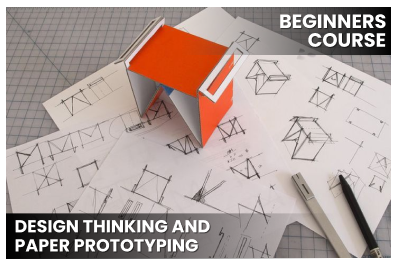There are no items in your cart
Add More
Add More
| Item Details | Price | ||
|---|---|---|---|
Learn design thinking & paper prototyping techniques with this beginners course!
9 hours LIVE courseLanguage: English
Unleash your inner designer! This course equips you with design thinking for creating user-centric solutions. Through hands-on projects, you'll master the design process, from identifying problems to crafting solutions.
In a student-led sprint, you'll tackle your own design challenge, guided by a mentor. This fun and interactive course is perfect for anyone who wants to transform their creative ideas into reality.
Batch Options:
Tuesdays 8-9 pm IST (9 classes of 60min each).
Please register to get added to the course's waiting list.
Chapter Breakdown:
Chapter 1 - Introduction to Design Thinking: Ever wondered how innovative products come to life? This session unlocks the power of design thinking, a human-centered approach to problem-solving. We'll explore the "Six Thinking Hats" tool to equip you with multiple perspectives when tackling challenges. Dive into the "Double Diamond Process," a framework that guides you through the design journey. By deconstructing existing products, you'll gain valuable insights into user needs and product functionality.
Chapter 2- Product Breakdown and Stakeholders: No design exists in a vacuum. In this session, we'll delve into stakeholder mapping, a technique to identify key players and their needs. We'll explore what constitutes "good design" by considering various viewpoints, ensuring your solution resonates with all stakeholders. Finally, you'll learn how to craft a clear and concise problem statement that defines the core challenge you're aiming to solve.
Chapter 3- Research: Before designing solutions, we need to understand the users. This session focuses on defining your "area of intervention," the specific context where your design will come to life. We'll equip you with powerful user research tools like Empathy Mapping and Journey Mapping to gather in-depth insights. Master the art of asking "How Might We..." questions to spark creative brainstorming around user needs. Finally, you'll aim to organize and present your research findings in a clear and compelling research deck.
Chapter 4- Problem Statement: Get ready to think big! This session explores brainstorming techniques and mind mapping to transform your thoughts and research insights into an organized and comprehensible chart. By refining your problem statement based on user research, you'll ensure you're tackling the right challenge. Craft a compelling design proposal outlining your solution direction, and learn how to create moodboards that visually capture the essence of your design.
Chapter 5- Ideation and Iteration: This session is all about transforming ideas into potential solutions. We'll introduce you to the SCAMPER method, a powerful tool for generating a multitude of creative ideas and pushing boundaries. Learn to evaluate your ideas using the SWOT framework, identifying strengths, weaknesses, opportunities, and threats.
Chapter 6- Developing and prototyping: Have a great idea but unsure how to test it? This session dives into the world of prototyping, a crucial step in design thinking. You'll learn why prototyping is essential and how it helps refine your design based on user feedback. We'll explore the power of low-fidelity prototyping using cardboard, allowing you to quickly build a physical representation of your idea for early user testing.
Chapter 7- Prototyping: Building on your previous session, we'll refine your ideas and select the most promising concept for further development. This session provides a hands-on opportunity to put your prototyping skills into practice. With instructor guidance, you'll transform your chosen idea into a low-fidelity prototype using cardboard, ready to be tested and receive valuable user feedback.
Chapter 8- Testing: Design thinking is an iterative process, constantly evolving based on user feedback. In this session, you'll learn about user testing, a method to gather insights on how users interact with your prototype. User testing often reveals unexpected challenges and opportunities for improvement. We'll also explore the concept of sustainable design, considering ways to incorporate environmentally friendly practices into your design decisions.
Chapter 9- Introduction to Branding, Course Recap: Your design is taking shape! This session introduces you to crafting a brand identity that aligns with your solution and resonates with your target audience. Learn how to effectively document your design journey, capturing the evolution of your ideas and decisions.
Material Required:
Class 1: Introduction to Design Thinking
[No Materials Required]
Class 2: Product Breakdown and Stakeholders
[No Materials Required]
Class 3: Research → Has Assignment
Access to Miro Board and Google Slides
Class 4: Problem Statement → Has Assignments
Access to Miro Board and Google Slides
Class 5: Ideation and Iteration → Has Assignment
Blank A4 or A3 sheets for drawing
Pencils, pens, erasers, sticky notes
Class 6: Developing and prototyping → Has Assignment
Making Material - Corrugated Cardboard (at least 1mx1m), Cardstock sheet, Printing paper.
Basic stationery - Metal ruler, Pencil, Pen, Eraser
Cutting tools- Exacto Knife, Box cutter, Cutting Mat
Joining Tools - Masking Tape, Superglue, Wooden Skewers, toothpicks, Rubber bands, Split pin paper fasteners
Class 7: Prototyping → Has Assignment
Making Material - Corrugated Cardboard (at least 1mx1m), Cardstock sheet, Printing paper.
Basic stationery - Metal ruler, Pencil, Pen, Eraser
Cutting tools- Exacto Knife, Box cutter, Cutting Mat
Joining Tools - Masking Tape, Superglue, Wooden Skewers, toothpicks, Rubber bands, Split pin paper fasteners
Class 8: Testing → Has Assignment
[No material required]
Class 9: Basic introduction to Branding, Course Recap → Has Assignment
Blank A4 or A3 sheets for drawing
Pencils, pens, erasers, sticky notes
Access to Miro Board and Google Slides
Learn live with top educators, chat with teachers and other attendees, and get your queries cleared.
Our curriculum is designed by experts to make sure you get the best learning experience.
Interact and network with like-minded folks from various backgrounds in exclusive chat groups.
Stuck on something? Discuss it with your peers and the instructors in the inbuilt chat groups.
Flaunt your skills with course certificates. You can showcase the certificates on LinkedIn with a click.
